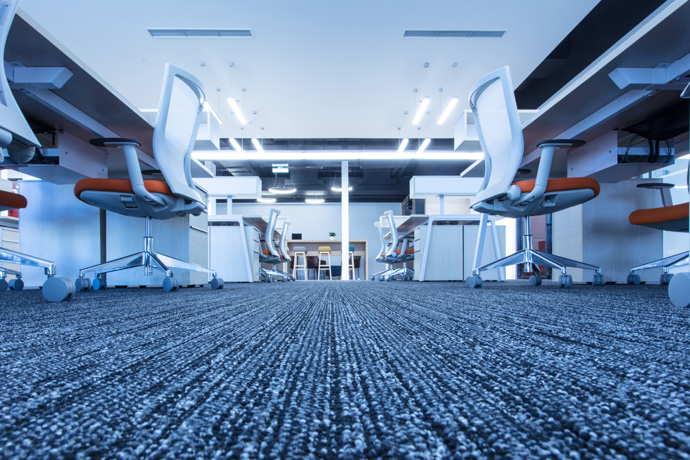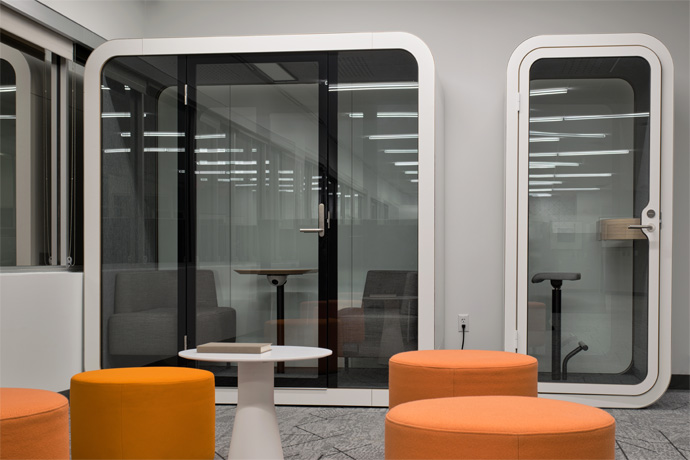October 10, 2025
Picture yourself trying to finish an important project while the HVAC hums overhead, footsteps echo from the hallway, and two coworkers chat across the room. It is frustrating, distracting, and exhausting. Noise is one of the most underestimated challenges in commercial design, yet it shapes how people experience a space every single day.
The right acoustic environment makes it easier to concentrate, reduces stress, and creates a setting where both employees and clients feel comfortable. When noise reduction is built into the design from the start, offices and commercial buildings not only work better, they feel better too.
Why Acoustic Design Matters

The Effects of Noise on Productivity and Wellness
Noise creates distraction, but its impact goes further. It affects how people think, feel, and perform. Research shows that uncontrolled background noise increases stress, reduces concentration, and lowers overall job performance. In offices, the constant hum of HVAC systems, footsteps from upper floors, or conversations in open-plan areas make focused work nearly impossible.
In healthcare, hospitality, or education, noise can interfere with communication and even safety. Acoustic planning reduces these risks and creates calmer environments where people can focus and thrive.
Common Sources of Noise in Commercial Spaces
HVAC, Foot Traffic, Equipment, and More
The first step in reducing noise is to understand its source. In commercial spaces, the culprits are often hiding in plain sight. HVAC systems, for example, bring comfort but also contribute a steady hum from airflow, fans, and ductwork, and if poorly designed, they can rattle or vibrate in ways that become a constant distraction. Footsteps across hard flooring in hallways and lobbies echo through the building, especially in high-traffic areas.
Office equipment like printers, copiers, or machinery adds bursts of sound that interrupt focus, while conversations in open offices or through thin walls carry farther than intended, making privacy harder to achieve. External noise is another factor, with street traffic, nearby businesses, or construction seeping in through windows, walls, and roofs.
Once the main sources are identified, builders and designers can map out targeted solutions that match the unique needs of the space.
Top Soundproofing Materials and Techniques

Acoustic Panels, Ceiling Tiles, and Insulation
Noise reduction involves two approaches: blocking sound from entering a space and absorbing sound within it. Both require the right combination of materials and installation methods.
Acoustic panels: Mounted on walls or ceilings, panels absorb sound waves to reduce echo and reverberation. They are available in many styles and finishes, which allows them to serve as design features.
Acoustic ceiling tiles: Dropped ceilings with sound-absorbing tiles remain one of the most effective ways to quiet offices. They reduce sound transfer between floors and create a calmer atmosphere below.
Insulation and wall assemblies: Specialized insulation in walls and ceilings cuts sound transmission between rooms. Staggered-stud or double-stud framing can further disrupt sound paths.
Flooring solutions: Carpeting, underlayment, and rubber-backed flooring materials help reduce impact noise from foot traffic.
Sealing gaps: Even small cracks around doors, windows, and ductwork allow sound to leak through. Proper sealing is a simple but crucial step in soundproofing.
When these materials are layered together, they provide comprehensive protection against unwanted noise while still complementing the design of the space.
Layout and Design for Better Sound Control

Room Placement and Sound Zoning
The layout of a building is just as important as the materials used. Smart design choices shape how sound moves through a space.
Room placement: Locating kitchens, copy rooms, or mechanical rooms away from workstations or meeting spaces prevents constant disruption.
Sound zoning: Grouping similar functions together limits noise spillover. For example, placing collaborative spaces near each other keeps quiet zones free from distractions.
Barriers and partitions: Glass partitions, movable walls, and even bookshelves can create effective sound barriers in open-plan layouts without reducing flexibility.
Ceiling height and shape: Tall ceilings can amplify sound. Angled walls, acoustic baffles, or suspended treatments help redirect it.
Outdoor considerations: Landscaping, fencing, and thoughtful building orientation buffer noise from busy roads or nearby properties.
When acoustic design is part of the overall architecture, businesses gain lasting value in both comfort and functionality.
Imagine a corporate office where employees are struggling to concentrate in an open-plan layout. Conversations carry, footsteps echo, and the overall noise makes focus difficult. With the addition of acoustic ceiling tiles, fabric wall panels, and carpeting, the space becomes noticeably quieter, and productivity quickly improves.
In a healthcare setting, patient privacy and comfort depend on keeping noise under control. A clinic that installs sound-insulated wall assemblies and acoustic doors creates exam rooms where conversations remain confidential and both staff and patients feel less stressed. The quieter environment helps improve efficiency and overall care.
Hospitality spaces also benefit from thoughtful acoustic design. A restaurant that introduces wall-mounted acoustic panels and ceiling baffles can completely change the dining experience. Guests notice they can finally enjoy meals and conversations without raising their voices, which leads to a more welcoming atmosphere and better reviews.
Invest in a Quieter Workspace
At DeLeers Construction, we integrate noise reduction solutions into every stage of design and construction. Our goal is to create spaces that are comfortable, functional, and built to support the people who use them. A quieter workspace is an investment in the long-term success and well-being of your business.
Message or call our experts at 920-347-5830 with any questions about hiring professionals for commercial construction projects!



